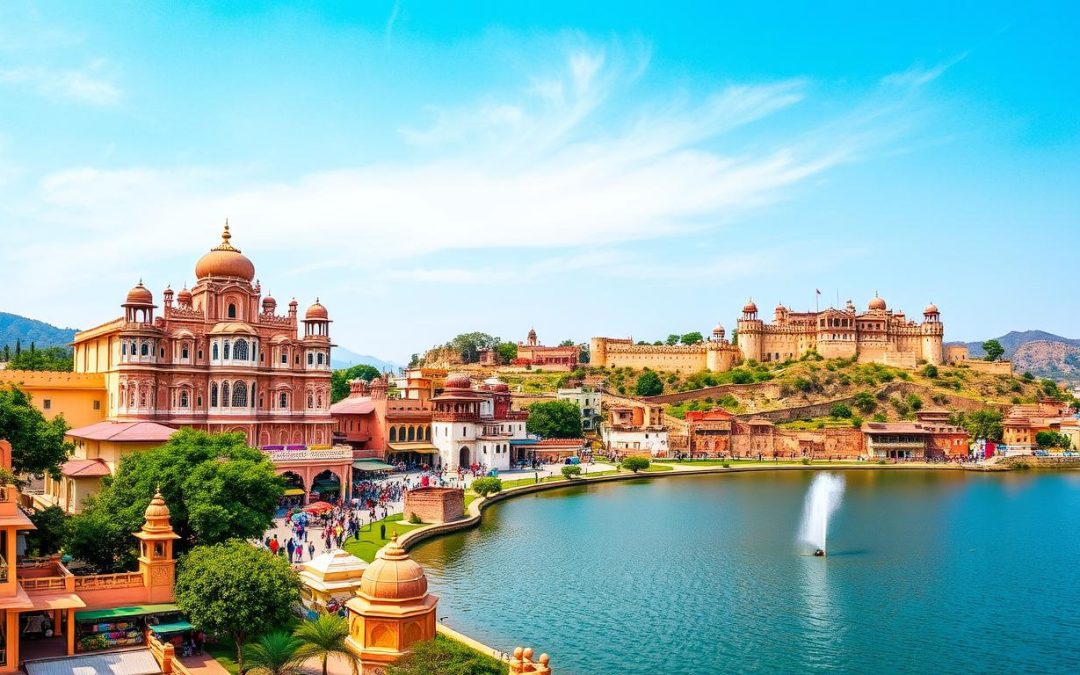Have you ever wondered what makes Jaipur the most mesmerizing destination in Rajasthan? Get ready to explore the magical world of the Pink City. Here, history comes alive in every stone, and colors dance around every corner.
Jaipur is more than just a city. It’s a vibrant mix of culture, architecture, and royal heritage. Known as the Pink City, it offers a unique look into India’s rich history. You’ll find stunning palaces and bustling markets, making it an adventure that will capture your senses and spark your imagination.
Your trip to Jaipur will show you architectural wonders like Hawa Mahal. You’ll see magnificent forts that tell stories of the past and markets that buzz with local life. Whether you love history, photography, or exploring cultures, Jaipur’s best experiences will amaze you.
Key Takeaways
- Explore the iconic Pink City with its unique terracotta-hued architecture
- Discover world-famous historical landmarks like Hawa Mahal and Amber Fort
- Experience the rich cultural heritage of Rajasthan
- Immerse yourself in vibrant local markets and traditional crafts
- Capture breathtaking photographs of architectural wonders
Overview of the Pink City of Jaipur
Jaipur is in the northwestern state of Rajasthan. It’s a vibrant city that shows India’s rich culture. The Pink City is known for its stunning architecture, royal history, and unique charm.
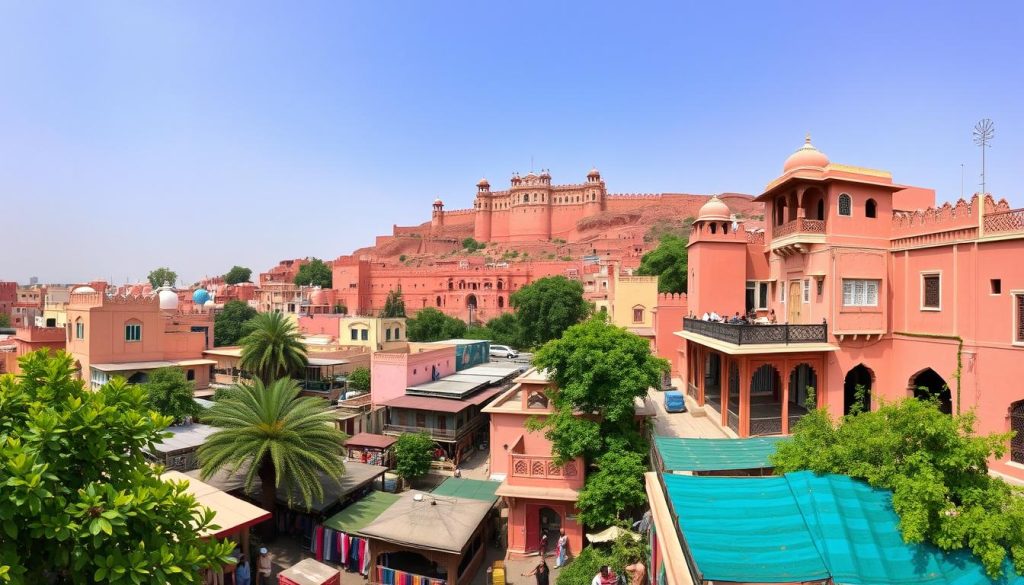
History and Cultural Significance
In 1876, Maharaja Sawai Ram Singh painted the city pink to welcome Prince Albert Edward. This made Jaipur a living canvas of culture. The Pink City is more than a color; it’s about hospitality, tradition, and royal grandeur.
“A city painted in pink, where every wall tells a story of royal welcome and cultural pride.”
Best Time to Visit
Choosing the right time to visit Jaipur is important. The best time is from December to March. The weather is cool and perfect for exploring.
- Winter (December-March): Ideal temperatures, perfect for sightseeing
- Summer (April-June): Extremely high temperatures, less recommended
- Monsoon (July-September): Moderate rainfall, lush landscape
Getting Around Jaipur
Exploring Jaipur is an adventure. You can choose from many ways to see the city’s attractions:
| Transportation Mode | Cost Range | Convenience Level |
|---|---|---|
| Auto-rickshaws | Affordable | High |
| Taxi/Cab | Moderate | Very High |
| Public Bus | Cheap | Low |
| Rental Bike/Scooter | Economical | Medium |
Pro tip: Hire a local guide or join a guided tour. This will help you enjoy Jaipur’s history, culture, and modern life.
Amber Fort: A Magnificent Historical Marvel
Nestled in the rugged hills of Jaipur, Amber Fort is a stunning example of Rajputana architecture. It shows the grandeur of the royal past. This UNESCO World Heritage Site lets you travel back in time and see the rich heritage of Rajasthan.
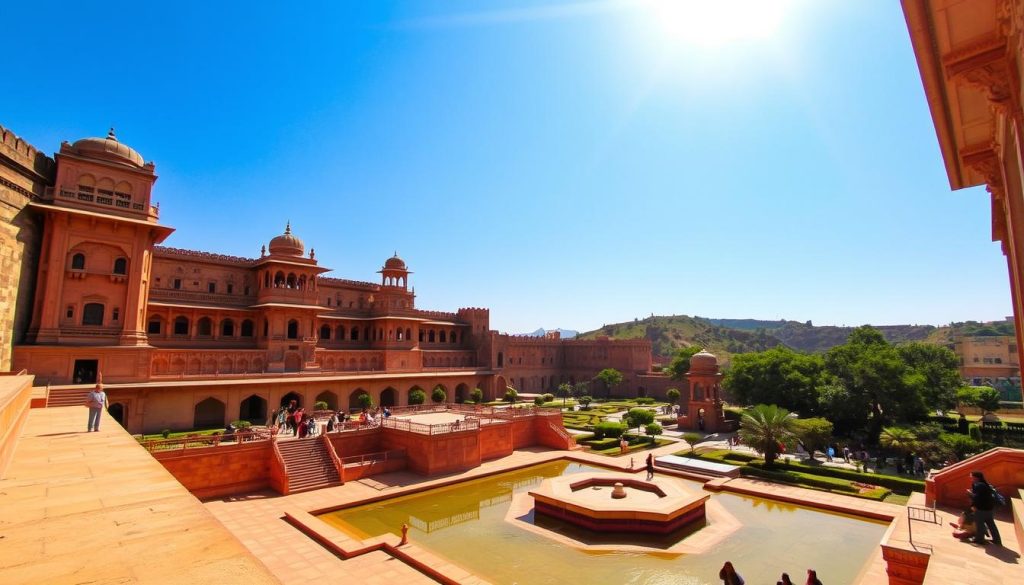
Palace Architecture and Design
Built in 1592, Amber Fort combines Rajput and Mughal architectural styles. Its design is truly remarkable:
- Stunning sandstone and marble construction
- Elaborate courtyards with mesmerizing geometric patterns
- Exquisite pastel-colored walls and intricate archways
Must-See Spots Within the Fort
Make sure to visit these amazing spots in Amber Fort:
- Jaleb Chowk: The main courtyard welcoming visitors
- Diwan-E-Aam: The Hall of Public Audience
- Sheesh Mahal: The breathtaking Mirror Palace
Photography and Viewing Points
Here are the best spots to capture the fort’s beauty:
- Great Wall of Amer viewpoint (requires climbing 350 steps)
- Sunset photography spots overlooking Maota Lake
- Courtyard perspectives showcasing architectural details
“Amber Fort is not just a monument, but a journey through Rajasthan’s royal history.” – Local Historian
| Visitor Information | Details |
|---|---|
| Entry Cost for Foreigners | INR 550 |
| Recommended Exploration Time | 3 hours |
| Light and Sound Show | 6:30 PM Daily (INR 295) |
Amber Fort is a must-see in Jaipur. It offers a journey through architectural wonders and royal history.
Exploring the City Palace Complex
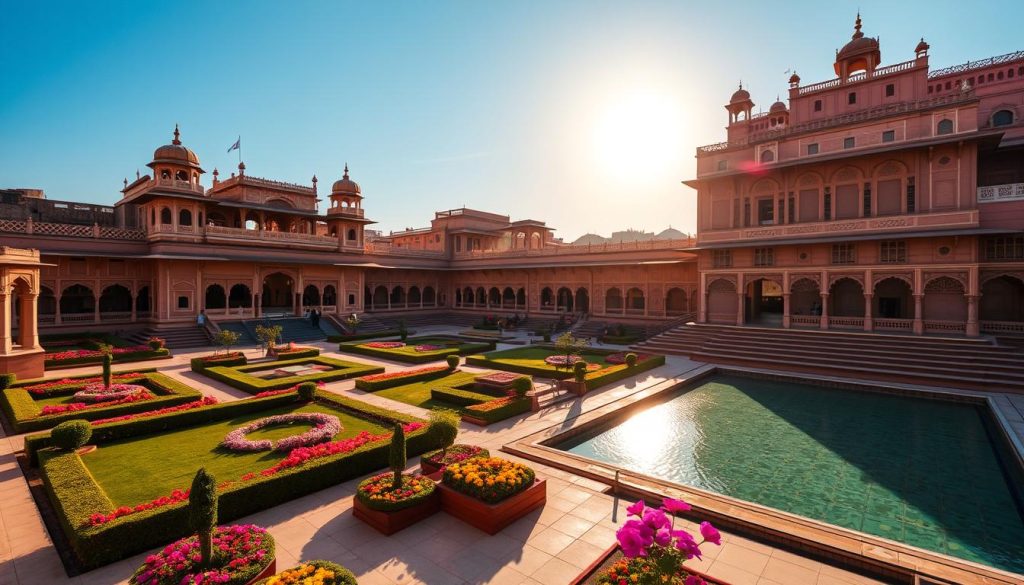
Walking into the City Palace is like stepping into Rajasthan’s royal history. Built from 1729 to 1732, it mixes Rajput, Mughal, and European styles. It shows the vision of Maharaja Sawai Jai Singh and the skills of Vidhyadhar Bhattacharya and Sir Samuel Swinton Jacob.
The palace’s details and cultural importance will amaze you. It has many levels, with the Chandra Mahal having seven floors. The royal family still lives there. Each part of the City Palace shares a story of Jaipur’s royal past.
- Pritam Niwas Chowk: See the famous courtyard with its four gates, each for a season and a Hindu deity
- Mubarak Mahal: A museum of royal clothes and detailed crafts
- Diwan-e-Khas: Houses the world’s largest sterling silver urns, weighing 345 kgs
Here’s what you need to know about visiting this Jaipur attraction:
- Opening hours: 9:30 AM to 5 PM daily
- Entry fees: INR 700 (about $9 USD) for foreign visitors
- Recommended visit time: 3+ hours to fully enjoy
“The City Palace is not just a monument, but a living narrative of Rajasthan’s royal heritage.” – Royal Historian
Make sure to see this incredible palace complex. Every corner tells a part of Jaipur’s cultural story. It’s a must-see for history lovers and casual visitors.
Hawa Mahal: The Palace of Winds
Explore the stunning Hawa Mahal, a key part of Jaipur’s royal past. This iconic Palace of Winds shows the city’s rich history. It invites visitors to see its unique design and learn about its past.
Architectural Beauty and History
The Hawa Mahal is a five-story palace made from red and pink sandstone. Built in 1799, it has 953 tiny windows called jharokhas. These windows were made to keep the palace cool in Jaipur’s hot summers.
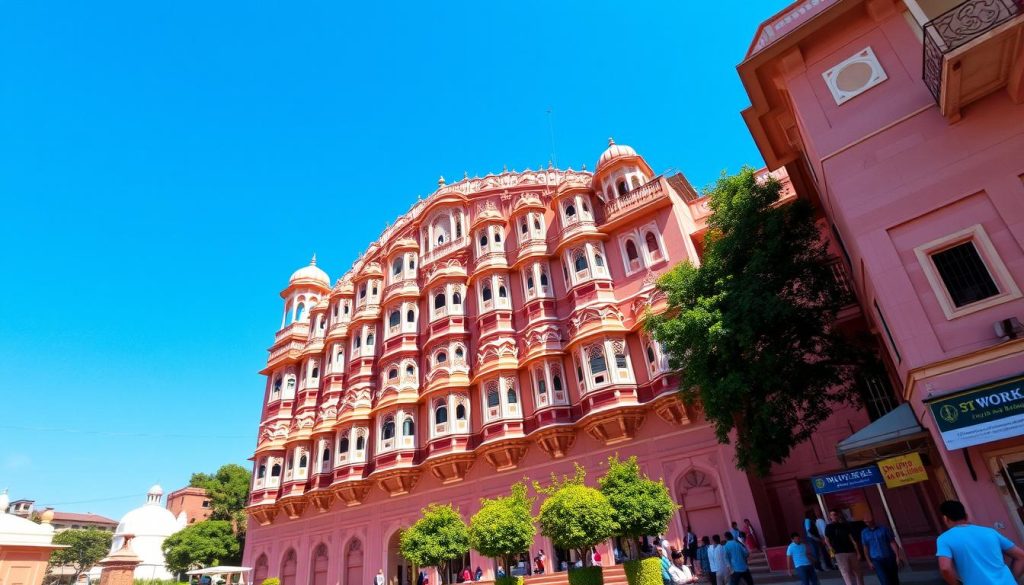
Best Photo Spots and Viewing Times
Here are some tips for taking amazing photos of the Hawa Mahal:
- Sunrise: Soft golden light illuminates the palace’s facade
- Sunset: Dramatic shadows create stunning visual contrast
- Early morning (9:00 AM): Optimal lighting and fewer crowds
“The Hawa Mahal is not just a building, but a window into Rajasthan’s royal past.” – Local Jaipur Guide
Nearby Attractions and Cafes
Make your visit to the Hawa Mahal even better by checking out nearby spots and cafes. Wind View Cafe and Tattoo Cafe have great views of the palace. You can enjoy tasty local treats while taking in the sights.
Practical Visitor Information:
- Entrance Fee: Approximately USD 3
- Visiting Hours: 9:00 AM to 4:30 PM, seven days a week
- Part of the Composite Ticket (USD 14) for multiple attractions
Jantar Mantar and Cultural Heritage
Explore the amazing world of astronomy at Jantar Mantar, a stunning symbol of Jaipur’s rich history. Built in 1724 by Maharajah Sawai Jai Singh II, it’s the largest stone observatory globally. It showcases incredible scientific skill.
“The instruments of Jantar Mantar are not just stone structures, but windows into the astronomical brilliance of 18th-century Rajasthan.”
At this site, you’ll see 19 unique astronomical instruments that still impress today. The Brihat Samrat Yantra, a huge sundial, stands 27 meters tall. It can measure time with just two seconds of error!
- UNESCO World Heritage Site
- 19 architectural astronomical instruments
- World’s largest stone observatory
- Built in 1724 by Maharajah Sawai Jai Singh II
Jantar Mantar is more than an astronomy site. It shows Jaipur’s love for learning and science. It gives visitors a special look into Rajputana’s math and astronomy achievements.
| Instrument Highlight | Unique Feature |
|---|---|
| Brihat Samrat Yantra | World’s largest stone sundial (27 meters high) |
| Equinoctial Dial | Measures time with 2-second accuracy |
| Astronomical Instruments | Total of 19 precision measuring devices |
Visiting Jantar Mantar is like stepping into a museum of science. Each stone device shares a story of Jaipur’s unique blend of math and astronomy.
Markets and Shopping Experiences
Jaipur shopping is an exciting adventure through colorful markets. These places are full of culture and craftsmanship. You’ll find traditional Rajasthani treasures and unique local experiences.
Bapu Bazaar Highlights
Bapu Bazaar is a top spot for shopping in Jaipur. It’s a lively market that shows the city’s rich textile and handicraft traditions. You’ll see stunning textiles, colorful fabrics, and traditional Rajasthani clothing.
- Vibrant cotton and silk textiles
- Hand-block printed fabrics
- Traditional Rajasthani garments
- Affordable pricing ranges
Local Crafts and Souvenirs
Jaipur shopping isn’t complete without local artisan crafts. The markets have a wide range of souvenirs that show Rajasthan’s artistic heritage.
| Craft Type | Price Range | Recommended Stores |
|---|---|---|
| Hand Block Printed Textiles | Rs. 500-1,500 | Anokhi, Cottons |
| Traditional Jewelry | Rs. 1,000-8,000 | Johari Bazaar |
| Pottery and Ceramics | Rs. 200-1,000 | Local Artisan Shops |
Bargaining Tips
Bargaining is a skill in Bapu Bazaar and Jaipur markets. Start by offering 30-40% less than the initial price and be prepared to negotiate with a friendly, respectful approach. Bargaining is a big part of the cultural shopping experience.
“Shopping in Jaipur is not just a transaction, it’s a cultural dialogue.” – Local Artisan
For successful Jaipur shopping, visit markets early morning or late evening. Carry cash and show interest in the craftsmanship of each item.
Jal Mahal and Other Hidden Gems
Discover the enchanting Jal Mahal, one of Jaipur’s most mesmerizing hidden gems. This stunning water palace sits gracefully in the middle of Man Sagar Lake. It offers a breathtaking sight that captures the imagination of every traveler.
The Jal Mahal appears to float magically on the water, creating a picturesque scene. This scene defines the beauty of Rajasthan’s architectural wonders.
When exploring the hidden gems in Jaipur, you’ll want to know the best times to visit Jal Mahal. Early morning and sunset provide the most spectacular views. Golden light reflects off the palace’s surfaces during these times.
Entry to the Jal Mahal itself is free. However, boating charges apply for those wanting a closer look.
- Best viewing times: Early morning and sunset
- Photography opportunities: Stunning lake reflections
- Nearby attractions: Man Sagar Lake promenade
Beyond Jal Mahal, Jaipur offers several other remarkable hidden gems that most tourists overlook:
- Galtaji Temple (Monkey Temple) – A unique archaeological site nestled in a mountain pass
- Nahargarh Fort – Offers breathtaking panoramic views of the Pink City
- Panna Meena ka Kund – A stunning stepwell known for its remarkable symmetry
“Jaipur’s hidden gems reveal the city’s true magic beyond its most famous monuments.” – Local Travel Guide
For an unforgettable experience, take time to explore these lesser-known attractions. Each hidden gem offers a unique glimpse into Jaipur’s rich cultural tapestry. They provide memories that go far beyond typical tourist paths.
Where to Stay and Dining Options
Finding the right place to stay in Jaipur can make your trip unforgettable. The city has everything from old-world hotels to affordable choices. There’s something for everyone, no matter your budget or preferences.
Luxury Stays in Jaipur
Looking for top-notch places to stay? Jaipur has some amazing options:
- Rambagh Palace: A royal experience with 5 on-site restaurants
- The Oberoi Rajvilas: Spanning 32 acres with luxury amenities
- The Leela Palace: Offering rooms, suites, and private villas
Budget-Friendly Options
If you’re watching your budget, check out Bani Park and Raja Park. These areas offer affordable stays without sacrificing comfort.
| Area | Accommodation Type | Key Features |
|---|---|---|
| Bani Park | Budget Hotels | Peaceful atmosphere, affordable rates |
| C Scheme | Upscale Hotels | 5-star establishments, luxury amenities |
Culinary Experiences
Jaipur’s restaurants take you on a flavorful journey. From traditional Rajasthani dishes to modern cuisine, there’s something for everyone. Don’t miss these spots:
- Laxmi Mishtan Bhandar (LMB): A 300-year-old culinary institution
- Meraaki Kitchen: Featuring dishes by a MasterChef India finalist
- Bar Palladio: Unique interiors blending European and Mughal aesthetics
“Jaipur’s dining scene is a perfect blend of traditional flavors and modern culinary innovation.” – Local Food Critic
Your food adventure in Jaipur will be as vibrant as the city. You’ll find everything from street food to fine dining.
Planning Your Trip to Jaipur
Planning your trip to Jaipur is all about making the most of your time in this lively city. The best time to visit is from October to March. During these months, the weather is mild, perfect for exploring the city’s UNESCO sites and cultural spots.
Winter is the best time for sightseeing. The daytime temperatures are around 25 degrees Celsius (77 degrees Fahrenheit). This makes it easy to enjoy the city without the heat.
When planning your Jaipur trip, set aside two to three days for the main sights. Jaipur is close to Delhi and Agra, making it easy to visit these places too. Indian Railways has fast trains from Delhi, making travel easy. Hotels offer good deals in April and May, great for budget travelers.
For those who love culture, visiting during festivals like Holi in March or Diwali in late October or early November is a must. The Jaipur Literature Festival in January is also a highlight, attracting world leaders. Don’t forget to pack light, breathable clothes and stay hydrated, especially in summer when it can get very hot.
Getting ready for Jaipur is important. Learn about local customs, dress modestly, and be ready for the city’s busy vibe. With good planning and an open mind, your trip will be filled with unforgettable cultural experiences and amazing sights.
The above is subject to change.
Check back often to TRAVEL.COM for the latest travel tips and deals.
Here are some Tours & Sightseeing suggestions that might pique your interests!
